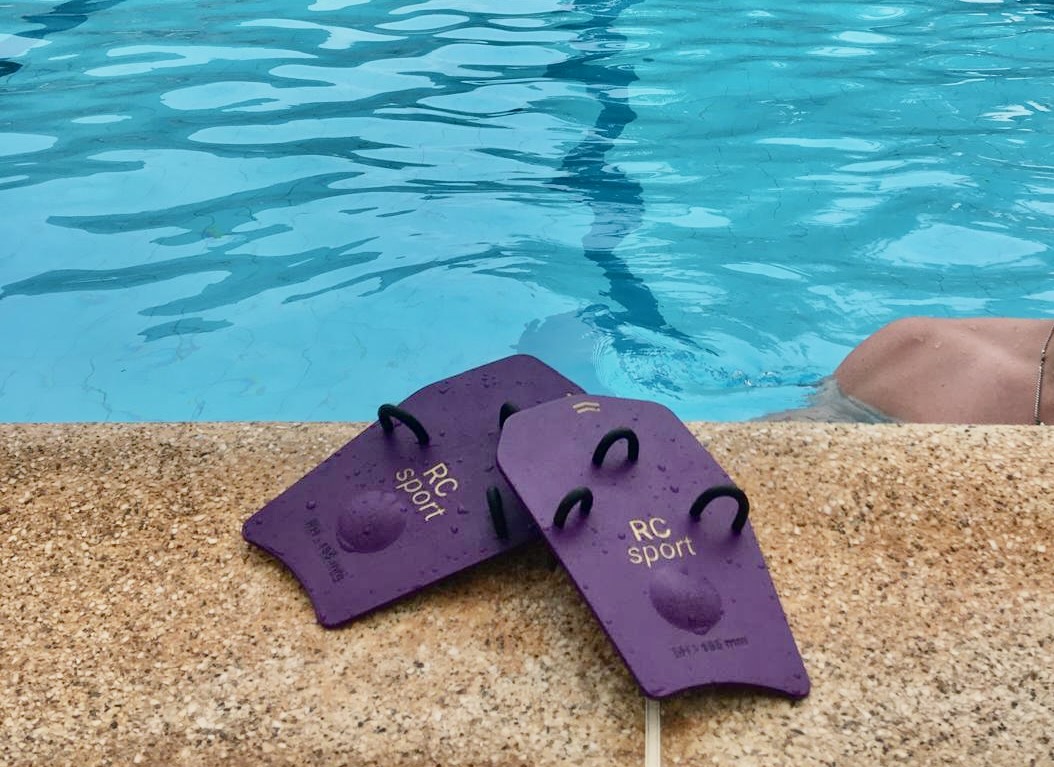One of the best feelings imaginable is swimming fast – gliding through the water, cruising up and down a hotel pool after sunset, reaching with every stroke through the turquoise blue water and slicing through the glittering sunset yellow reflections, tumble-turning, pushing off the wall and cruising yet more…
The performance paddles were built for stroke, power and speed, but last week, I was using them for pure enjoyment.
I’ve been using the RC Sport performance paddles for a few months and wanted to share my impressions and experience.
The paddles were designed by engineer, swimmer (and friend), Ed Rafipay. I have known Ed for about 20 years. We trained together at the University of Bath and competed at national and international level in swimming.
When I met Ed at the National Masters last year, he told me that he was working on some paddles and needed some fast swimmers to test them.
I have generally always used paddles in training and I have, at times used paddles quite intensely even during main sets. However, my most recent club has limited time dedicated to paddles, so most of my impressions here come from solo training sessions.
For reference a club training might be 3-4k and a solo session is usually shorter (till I get bored) which is about the 2k mark but usually much more sprint orientated. Also reference, my Pb is a 52 for the 100f/s.
I have owned about about 5 or 6 different pairs of paddles in the past. Some have been appalling – so bad, that I have chucked them almost immediately. I have never liked the rigid cupped paddles, they never really ‘felt right’. The paddles I preferred so far were the Speedo power paddles which are slightly larger (maybe 130% of hand size) with a slightly more flexible plastic and dotted with holes.
One thing I should say: I’ve always been curious about the physics behind the paddles: what’s the rationale for the holes, shape, outline, finger positioning etc. There didn’t seem to be anything particularly convincing in terms of the rationale behind the design decision, and more importantly which paddles should one use for which purposes.
So, anyway, when Ed said he had developed some paddles, and I was curious. As far as I knew, Ed’s background was huge complex engineering projects, so I was keen that he had applied his experience to something more directly applicable to me – and also something that could help me.
In the end it helped me directly in two ways. But first:
Getting my hands on the paddles.
So the first thing, is that you need to measure your hand. Seems completely sensible in hindsight, and made me wonder why other paddles only offered two or three sizes.
I sent the details off to RC sport, paid and received the paddles about a week later through the post.
Looking at them, the design is novel, they’re a sort of geometric shape, which surprised me because I always thought anything to do with water should be curved. But the polygonal shape matches the more-or-less hexagonal shape of the hand when the fingers are slightly spread. I guess that’s the first thing – the paddles force you to think about your finger positioning; slightly spread is the optimal spacing. It’s easy not to have the consciousness of this so this helped with the finger position.
It’s not immediately clear which paddle goes with which hand. Thankfully there’s a little indication to show which hand goes belongs with which paddle.
There’s also a marking to indicate where your middle finger should be placed as a reference point. There’s also a raised bubble to slot into the palm of your hand.
First impression: you know exactly where your hand should be in relation to the paddle. This is important because of the application of force. I’ve noticed with other paddles that sometimes, the application of force is unevenly spread meaning that the main purchase comes through the points of the fingers rather than the whole palm / wrist / arm.
Jumping into the water
First noticeable sensation is that the paddles are not forgiving. If the technique is not accurate (in that, if you are not applying the requisite force with good technique at the right time) then your hand will slip sideways. That’s important. The basis for almost every sport is proper technique and posture. It’s the foundation for the force through water but also the avoidance of bad posture and injury later on. By ‘stressing’ technique they automatically highlight any slight flaws.
After a few lengths I noticed that my left arm was slipping about 1/5 through the catch. The paddles highlight this noticeably which means I can begin to rectify that. The only way to rectify any problem is first to find the problem – perhaps this was a problem that I had had for many years without noticing.
So that was the first way that the paddles helped me. I may have inadvertently built up a bad habit and this helped to rectify that.
But more than that, the paddles help you to enjoy that sensation of applying force and feeling yourself pull yourself through the water efficiently.
Review
So: You’re traveling abroad with only hand luggage. Do you pack the paddles? Yes! You pack them and you get in the pool and glide. And for me this was the greatest benefit, they helped me to reenjoy one of the best feelings which is simply gliding through the water. I had become bored of routine training sessions in grotty pools. I wanted to appreciate the feeling of strong, smooth swimming – and they do that. I’ve used them in every session and will continue to use them.

